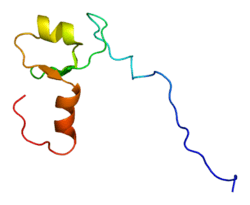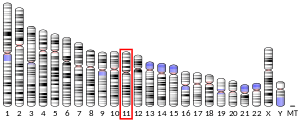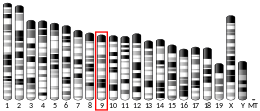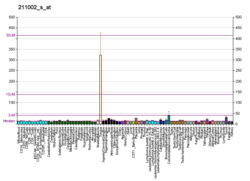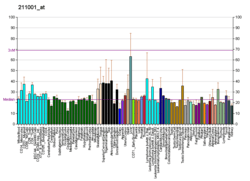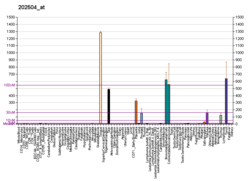TRIM29
Tripartite motif-containing protein 29 is a protein that in humans is encoded by the TRIM29 gene.[5][6]
Function
The protein encoded by this gene belongs to the TRIM protein family. It has multiple zinc finger motifs and a leucine zipper motif. It has been proposed to form homo- or heterodimers which are involved in nucleic acid binding. Thus, it may act as a transcriptional regulatory factor involved in carcinogenesis and/or differentiation. It may also function in the suppression of radiosensitivity since it is associated with ataxia–telangiectasia phenotype.[6]
Interactions
TRIM29 has been shown to interact with TRIM23[5] and GCC1.[7]
gollark: `AbstractVirtualModuleFactoryFlyweightVisitorBuilderImpl<W, H, Y>`
gollark: Also. I am not sarcastic.
gollark: A binary BF encoding is something which I'd expect to already exist.
gollark: I don't see why not.
gollark: Yes, and if you have Code Page 437 or whatever stuff then each character represents a byte, so it's fine.
References
- GRCh38: Ensembl release 89: ENSG00000137699 - Ensembl, May 2017
- GRCm38: Ensembl release 89: ENSMUSG00000032013 - Ensembl, May 2017
- "Human PubMed Reference:". National Center for Biotechnology Information, U.S. National Library of Medicine.
- "Mouse PubMed Reference:". National Center for Biotechnology Information, U.S. National Library of Medicine.
- Reymond A, Meroni G, Fantozzi A, Merla G, Cairo S, Luzi L, Riganelli D, Zanaria E, Messali S, Cainarca S, Guffanti A, Minucci S, Pelicci PG, Ballabio A (May 2001). "The tripartite motif family identifies cell compartments". EMBO J. 20 (9): 2140–51. doi:10.1093/emboj/20.9.2140. PMC 125245. PMID 11331580.
- "Entrez Gene: TRIM29 tripartite motif-containing 29".
- Rual JF, Venkatesan K, Hao T, Hirozane-Kishikawa T, Dricot A, Li N, Berriz GF, Gibbons FD, Dreze M, Ayivi-Guedehoussou N, Klitgord N, Simon C, Boxem M, Milstein S, Rosenberg J, Goldberg DS, Zhang LV, Wong SL, Franklin G, Li S, Albala JS, Lim J, Fraughton C, Llamosas E, Cevik S, Bex C, Lamesch P, Sikorski RS, Vandenhaute J, Zoghbi HY, Smolyar A, Bosak S, Sequerra R, Doucette-Stamm L, Cusick ME, Hill DE, Roth FP, Vidal M (October 2005). "Towards a proteome-scale map of the human protein-protein interaction network". Nature. 437 (7062): 1173–8. doi:10.1038/nature04209. PMID 16189514.
Further reading
- Kapp LN, Painter RB, Yu LC, van Loon N, Richard CW, James MR, Cox DR, Murnane JP (1992). "Cloning of a candidate gene for ataxia-telangiectasia group D". Am. J. Hum. Genet. 51 (1): 45–54. PMC 1682873. PMID 1609804.
- Hosoi Y, Kapp LN (1994). "Expression of a candidate ataxia-telangiectasia group D gene in cultured fibroblast cell lines and human tissues". Int. J. Radiat. Biol. 66 (6 Suppl): S71-6. doi:10.1080/09553009414551891. PMID 7530755.
- Brzoska PM, Chen H, Zhu Y, Levin NA, Disatnik MH, Mochly-Rosen D, Murnane JP, Christman MF (1995). "The product of the ataxia-telangiectasia group D complementing gene, ATDC, interacts with a protein kinase C substrate and inhibitor". Proc. Natl. Acad. Sci. U.S.A. 92 (17): 7824–8. doi:10.1073/pnas.92.17.7824. PMC 41238. PMID 7644499.
- Murnane JP, Zhu Y, Young BR, Christman MF (1994). "Expression of the candidate A-T gene ATDC is not detectable in a human cell line with a normal response to ionizing radiation". Int. J. Radiat. Biol. 66 (6 Suppl): S77-84. doi:10.1080/09553009414551901. PMID 7836856.
- Maruyama K, Sugano S (1994). "Oligo-capping: a simple method to replace the cap structure of eukaryotic mRNAs with oligoribonucleotides". Gene. 138 (1–2): 171–4. doi:10.1016/0378-1119(94)90802-8. PMID 8125298.
- Leonhardt EA, Kapp LN, Young BR, Murnane JP (1994). "Nucleotide sequence analysis of a candidate gene for ataxia-telangiectasia group D (ATDC)". Genomics. 19 (1): 130–6. doi:10.1006/geno.1994.1022. PMID 8188213.
- Richard CW, Cox DR, Kapp L, Murnane J, Cornelis F, Julier C, Lathrop GM, James MR (1993). "A radiation hybrid map of human chromosome 11q22-q23 containing the ataxia-telangiectasia disease locus". Genomics. 17 (1): 1–5. doi:10.1006/geno.1993.1275. PMID 8406440.
- Laderoute KR, Knapp AM, Green CJ, Sutherland RM, Kapp LN (1996). "Expression of the ATDC (ataxia telangiectasia group D-complementing) gene in A431 human squamous carcinoma cells". Int. J. Cancer. 66 (6): 772–8. doi:10.1002/(SICI)1097-0215(19960611)66:6<772::AID-IJC11>3.0.CO;2-5. PMID 8647648.
- Suzuki Y, Yoshitomo-Nakagawa K, Maruyama K, Suyama A, Sugano S (1997). "Construction and characterization of a full length-enriched and a 5'-end-enriched cDNA library". Gene. 200 (1–2): 149–56. doi:10.1016/S0378-1119(97)00411-3. PMID 9373149.
- Tauchi H, Green C, Knapp M, Laderoute K, Kapp L (2000). "Altered splicing of the ATDC message in ataxia telangiectasia group D cells results in the absence of a functional protein". Mutagenesis. 15 (2): 105–8. doi:10.1093/mutage/15.2.105. PMID 10719033.
- Colland F, Jacq X, Trouplin V, Mougin C, Groizeleau C, Hamburger A, Meil A, Wojcik J, Legrain P, Gauthier JM (2004). "Functional proteomics mapping of a human signaling pathway". Genome Res. 14 (7): 1324–32. doi:10.1101/gr.2334104. PMC 442148. PMID 15231748.
- Rual JF, Venkatesan K, Hao T, Hirozane-Kishikawa T, Dricot A, Li N, Berriz GF, Gibbons FD, Dreze M, Ayivi-Guedehoussou N, Klitgord N, Simon C, Boxem M, Milstein S, Rosenberg J, Goldberg DS, Zhang LV, Wong SL, Franklin G, Li S, Albala JS, Lim J, Fraughton C, Llamosas E, Cevik S, Bex C, Lamesch P, Sikorski RS, Vandenhaute J, Zoghbi HY, Smolyar A, Bosak S, Sequerra R, Doucette-Stamm L, Cusick ME, Hill DE, Roth FP, Vidal M (2005). "Towards a proteome-scale map of the human protein-protein interaction network". Nature. 437 (7062): 1173–8. doi:10.1038/nature04209. PMID 16189514.
- Hosoi Y, Kapp LN, Murnane JP, Matsumoto Y, Enomoto A, Ono T, Miyagawa K (2006). "Suppression of anchorage-independent growth by expression of the ataxia-telangiectasia group D complementing gene, ATDC". Biochem. Biophys. Res. Commun. 348 (2): 728–34. doi:10.1016/j.bbrc.2006.07.115. PMID 16890201.
- Beausoleil SA, Villén J, Gerber SA, Rush J, Gygi SP (2006). "A probability-based approach for high-throughput protein phosphorylation analysis and site localization". Nat. Biotechnol. 24 (10): 1285–92. doi:10.1038/nbt1240. PMID 16964243.
This article is issued from Wikipedia. The text is licensed under Creative Commons - Attribution - Sharealike. Additional terms may apply for the media files.
